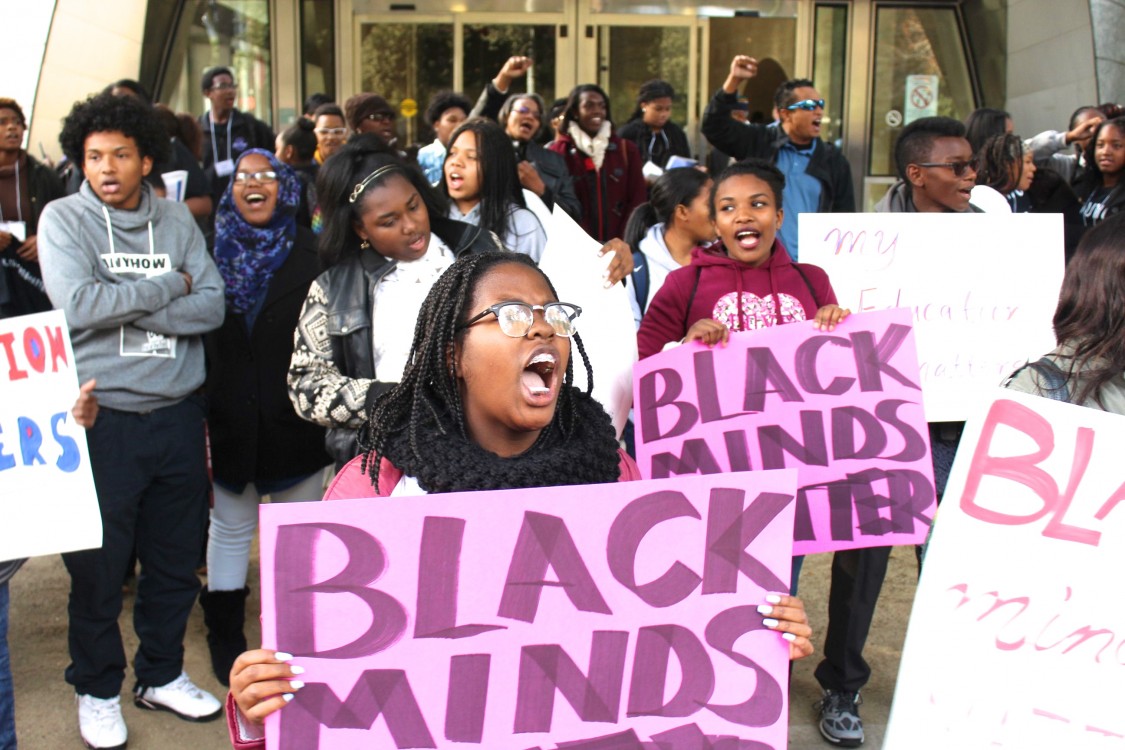
Student activism has made a comeback. With recent campus demonstrations against alleged racial discrimination and in favor of free college tuition, America may be facing a wave of student protest to a degree not seen since the 1960s. While the media focus on college campuses, very few journalists are acknowledging the activism that has been occurring at the high school level. Just in the past year, high school students across the country have protested against racist police brutality, curriculum changes, budget cuts, the expansion of charter schools, standardized tests and other youth-related issues.
After the white police officers responsible for the 2014 deaths of unarmed black men Michael Brown and Eric Garner were not indicted, high school students across the country organized solidarity protests in Seattle; New York; Denver; Oakland, California; Minneapolis and Boston. In February, about 250 high school students in Santa Fe, New Mexico left school to protest constant testing and the state’s new mandated exam. In June, Milwaukee high school students walked out of class to protest against the county executive takeover of low-performing schools.
And this fall, high school students in Allentown, Pennsylvania, organized a district-wide student walkout demanding the resignation of the superintendent, the inclusion of a student representative on the school board and summer youth employment opportunities. There were also student walkouts in Chicago; Berkeley, California and Philadelphia that occurred this fall.
High school activism is not limited to disruptive activities. Numerous youth organizations operate around the country to tackle issues concerning school closures, at-risk youth and the school-to-prison pipeline, among others.
It would be naive to assume that every student involved in these protests understands and cares about the issues, but it would be equally naive to argue that they are puppets serving adults’ ulterior motives. Too often, authority figures refuse to give youth activism respect because they assume that children cannot think for themselves. Even more pernicious, authority figures often belittle children’s grievances by arguing that youth activism is the work of outside agitators or claiming that students protest simply to skip school.
Considering the constant labeling of today’s youth as narcissistic and obsessed with their digital devices, it is disappointing that most adults do not appreciate youth activism. As long as the cultural belief that “children should be seen, not heard” continues, students’ voices will remain absent from discussions about school policies.
This recent wave of activism in high schools is not without precedent. Indeed, it is reminiscent of the often forgotten 1960s and 1970s high school student movement. With the exception of the 1968 East Los Angeles blowouts, a series of walkouts conducted by Chicano high school students, high school activism from this era has faded from public memory.
This is unfortunate, because high school activism has taken place in almost every major U.S. city, as well as in some suburban and rural areas. It has occurred in public, private, parochial and boarding schools. In 1969, the National Association of Secondary School Principals surveyed more than 1,000 public and private school principals about social unrest in secondary schools. The survey revealed that 56 percent of junior high schools and 59 percent of high schools reported disturbances.
By that year, secondary schools had experienced constant disruptions: racial violence, student walkouts, boycotts, sit-ins, arson attacks and more. Student activists remained aware of youth activism across the country and around the world through high school underground newspapers. They also formed school-based, city- and state-wide youth organizations to advocate for student rights and to stand in opposition to the Vietnam War and racism. Black, Latino, Asian and Native American students in particular called for ethnic studies, more minority faculty and better school facilities.
Believing that this unrest must have been orchestrated by adult agitators, school administrators hired security guards, banned high school chapters of “militant” political organizations and even worked with local police departments and the Federal Bureau of Investigation to monitor high school activists and youth groups.
Luckily for school administrators, the current wave of social unrest on high school campuses is nowhere near as large as that of the 1960s. However, recent developments reveal that some problems students protested against nearly 50 years ago still persist. Students of color still attend schools where the racial diversity of the student body is not reflected in the staff. Police officers are still present in many inner city schools, and far too often, students view them as posing a threat. Many public schools still lack basic resources to provide a sufficient education for low-income youth. Although high schools have changed dramatically since the 1960s, they are still plagued with numerous systemic issues that have been exacerbated by budget constraints.
Occasionally, youth activism receives national media attention. Examples include the student walkout at Spring Valley High School in support of School Resource Officer Ben Fields in October, and the walkout at Berkeley High School organized by the school’s Black Student Union in November. However, these incidents are only a small sample of the youth activism around the country that is never reported beyond local news outlets. Almost none of these events can be compared to the proliferation of articles about the recent student uprising at the University of Missouri and other college campuses.
High school students’ concerns also speak to larger societal issues in education. Too often, misbehaved children, especially students of color, capture the attention of political commentators because their actions seem to give credence to ideological narratives of out-of-control youth who have no respect for authority.
High school students are by definition a transient population, but this should not justify viewing their grievances as less important than those of their collegiate counterparts, who are no less transient. Children are too frequently viewed as objects rather than agents. Their status as minors forces them to go to great lengths to voice their opinions on issues that impact them the most. The least we can do is listen to them.
Aaron G. Fountain Jr. is a Ph.D. student in the Department of History at Indiana University in Bloomington, Indiana.
3 WAYS TO SHOW YOUR SUPPORT
- Log in to post comments
















